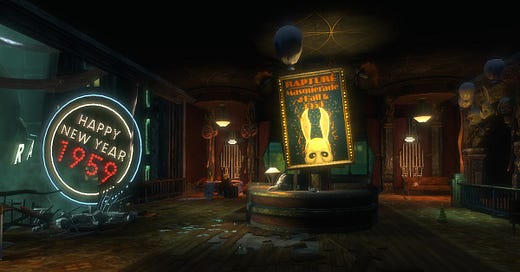I chose the impossible. I chose… Rapture. A city where the artist would not fear the censor. Where the scientist would not be bound by petty morality. Where the great would not be constrained by the small. And with the sweat of your brow, Rapture can become your city as well.”
-Andrew Ryan
I still remember swimming up to that lighthouse in the North Atlantic for the first time. Entering the dark hallway inside, I was both uneasy and intrigued as I slowly made my way to the posh bathysphere waiting within. As it began its descent into the depths, revealing the city of Rapture, I couldn’t help but feel a mix of fear and wonder.
A Brief History
Rapture was conceived in 1940 by Andrew Ryan, a visionary industrialist driven by the dream of a truly free world. Ryan envisioned Rapture as a haven where the greatest minds could flourish, unrestrained by government, religion, or societal norms.
The city was designed to be self-sustaining and reflected a sleek, modern aesthetic—a blend of the familiar and the progressive ideals of its time.
Despite Ryan's aspirations, Rapture's isolation and lack of oversight sowed the seeds of its downfall. The discovery of ADAM, a genetic material harvested from an unusual species of sea slug, marked the beginning of dark times. ADAM sparked a genetic revolution, granting extraordinary powers that were hailed as life-changing. Yet, it proved highly addictive, and its widespread use destabilized Rapture’s society.
As tensions mounted, the authoritarian grip of Andrew Ryan clashed with the growing unrest of the working class. Discontent boiled over into rebellion, culminating in a civil war that tore the city apart. Rapture, once envisioned as a utopia, descended into the dystopian nightmare we know today.
Environment
Rapture draws heavily from the Art Deco movement of the 1920s and 1930s, characterized by bold geometric shapes, metallic finishes, and over-the-top details. When combined with its undersea setting, this design creates an atmosphere that is both striking and haunting—an essential element of the BioShock experience.
The most haunting detail of Rapture lies in the remnants of a once-thriving society. Scattered throughout its decaying halls are items that speak to its vibrant past—tools of scientific advancement, personal belongings, and echoes of relationships long gone. Rapture's unique charm also comes from its modified technology—makeshift weapons, vending machines dispensing gene-altering serums, and improvised tools of survival.
In many ways, Rapture’s environment feels like a living character. Its hauntingly beautiful design conveys a tale of downfall, where opulence and innovation gave way to decay and chaos.
Level Design
The majority of the map follows a sort of hub-and-spoke design. Central hubs that lead to interconnected locations. The spaces themselves are often claustrophobic and dimly lit. High ceilings give the illusion of grandeur and space, but in reality, the confined layout keeps the player constantly aware of the city’s decay.
Environmental hazards are everywhere—oil slicks waiting to be ignited, deadly turrets, and, of course, the looming presence of Big Daddies patrolling their territories. These elements create constant tension and strategic opportunities, making every encounter feel dynamic and perilous.
Rapture’s story stands as a powerful cautionary tale, highlighting the perils of ambition, the consequences of extreme ideologies, and the fragility of utopian visions. It remains one of gaming’s most iconic locations to this day.
Image credits to https://bioshock.fandom.com/wiki. It's a great place to peruse if you want to know more.










"A Man Choses, A Slave Obeys." Ken is an ass but one hell of a writer. I worked with him on two projects as a publishing producer, and he was a nightmare.
Wow, this takes me back!